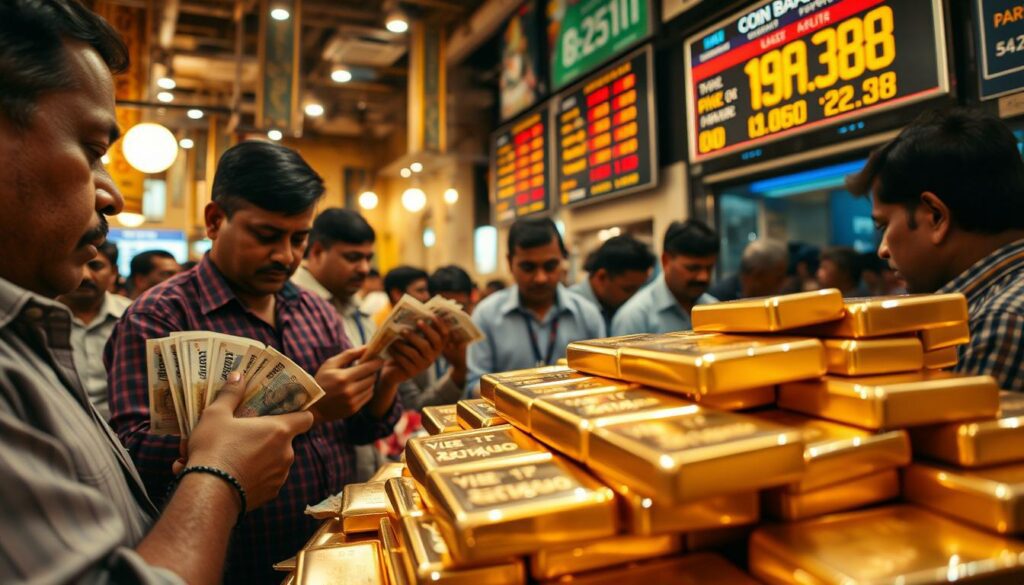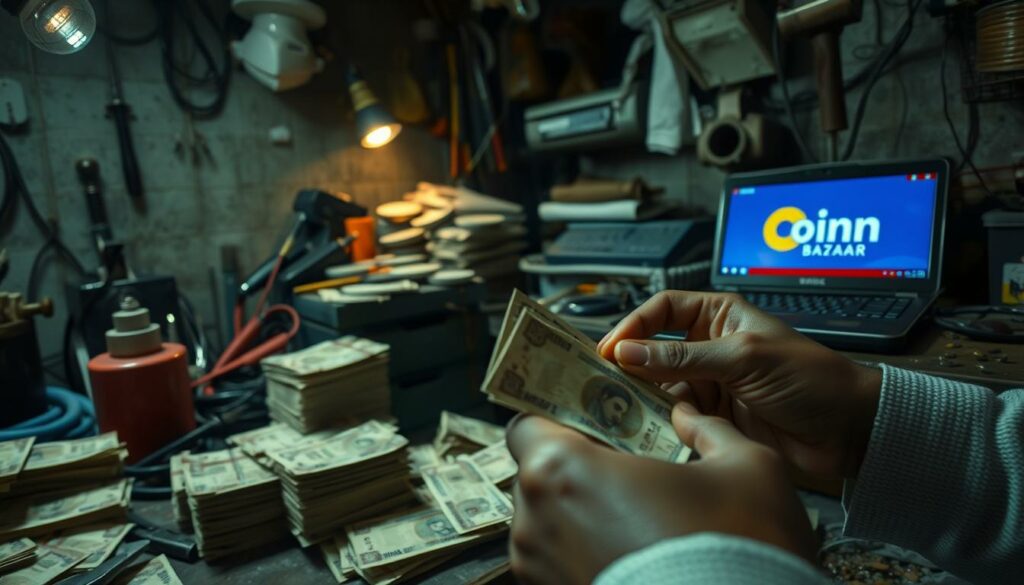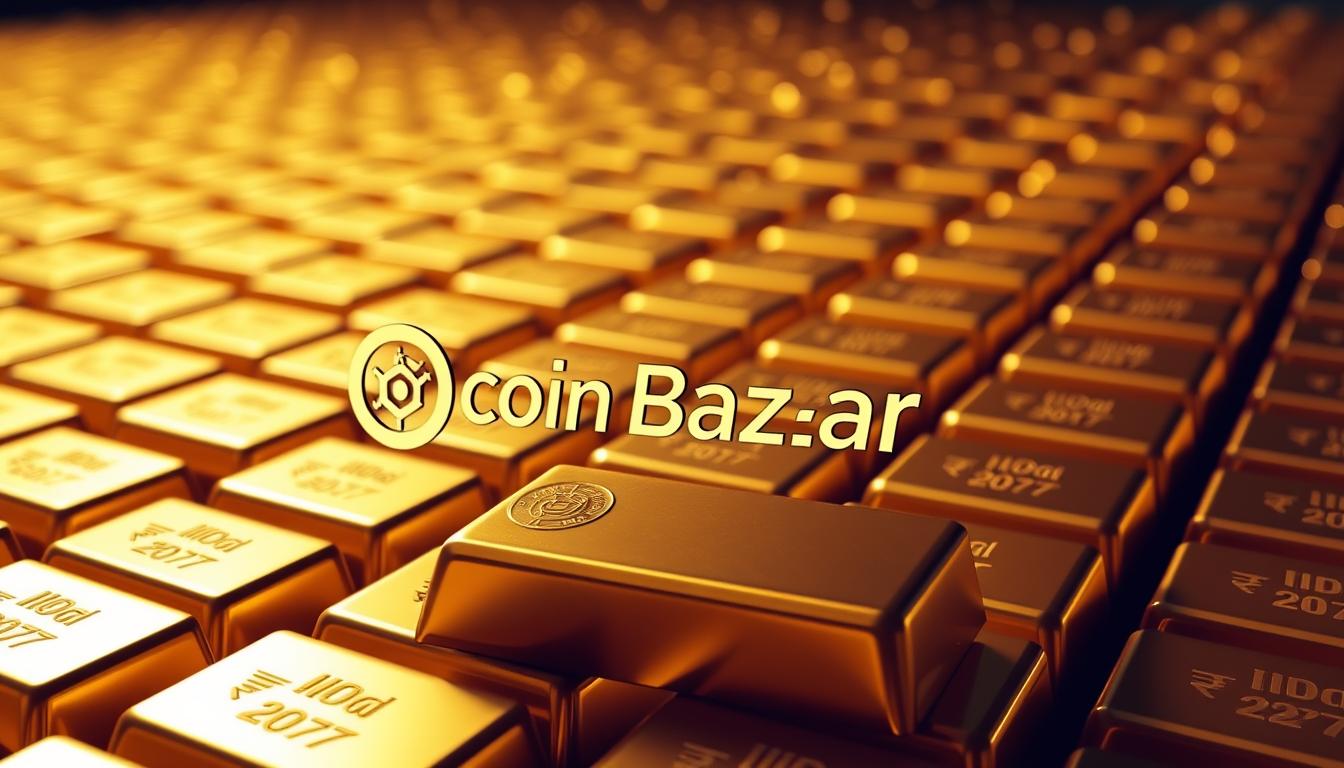As an investor in precious metals, you know how key authenticity is in bullion transactions. The precious metals market has struggled to prove the realness of its products. This has caused trust issues among investors.
Blockchain technology is changing the game. It brings more openness and safety to the industry. With a decentralized ledger, blockchain makes sure all deals are logged and checked. This makes it hard to change or fake the data.
This tech is especially important in precious metal trading. Here, being sure of what you’re buying is crucial. Thanks to blockchain, you can be confident that your investment is real and safe.
Key Takeaways
- Blockchain technology enhances transparency and security in precious metal trading.
- Decentralized ledger ensures that all transactions are recorded and verified.
- Authenticity of precious metals is ensured through blockchain.
- Investors can trust that their investment is secure and genuine.
- Blockchain is revolutionizing the precious metals industry.
The Current State of Bullion Transactions in India
Bullion transactions in India are complex, involving many players. This makes it hard to be transparent. You are part of a big market with a rich history and cultural importance.
Traditional Practices in Indian Precious Metals Market
The Indian precious metals market has many stakeholders. You work with refiners, wholesalers, and retailers, making things complicated. Trust is key in these deals, but transparency issues often arise.


Authentication Challenges Faced by Indian Buyers and Sellers
Indian buyers and sellers struggle to verify precious metals. Counterfeiting and tampering are big problems, leading to big financial losses. You need a secure and reliable way to check the authenticity of your bullion deals.
“Blockchain technology could change bullion transactions,” an expert notes. It could make secure bullion sales easier.
Knowing these challenges helps you see why a strong authentication system is crucial in precious metal trading.
Common Fraud Issues Plaguing the Precious Metals Industry
The precious metals industry faces many fraud issues. These threats can harm the trust in bullion transactions. As an investor, knowing about these risks is key to making smart choices.
There are several fraud areas in the precious metals market. It’s important to understand these to ensure secure bullion sales and investments.
Counterfeiting and Adulteration Problems
Counterfeiting and adulteration are big worries in the precious metals world. Counterfeiters make fake gold or silver that looks real. Adulteration mixes precious metals with cheaper ones to cheat investors.
“The counterfeiting of precious metals is a sophisticated crime that requires advanced techniques to detect.”
Documentation Fraud and Certificate Manipulation
Documentation fraud tricks people by altering documents. Certificate manipulation is when fake or altered certificates are used. These tricks make it hard to check if investments are real.


Supply Chain Vulnerabilities in India
The precious metals supply chain in India is complex and open to fraud. Fraud can happen at many stages, from import to sale. Keeping the supply chain safe is vital for secure bullion sales.
| Fraud Issue | Description | Impact |
|---|---|---|
| Counterfeiting | Creating fake precious metal bars | Financial loss for investors |
| Adulteration | Mixing base metals with precious metals | Reduced purity, financial loss |
| Documentation Fraud | Altering or forging documents | Difficulty in verifying authenticity |
Knowing about these fraud issues is the first step to protecting your investments. By understanding supply chain vulnerabilities and fraud, you can safeguard your money.
Fundamentals of Blockchain Technology for Precious Metals
Blockchain technology is changing the game in the precious metals industry. It offers a secure and transparent way to do transactions. You’ll see how it can change how we buy, sell, and own precious metals.
Blockchain Architecture and Distributed Ledger Basics
Blockchain is based on a decentralized and distributed ledger system. This means data is spread across many computers, not just one. It’s like a digital ledger book kept by many, not just one person.
The technology ensures transactions can’t be changed or deleted. This is thanks to advanced cryptography and a consensus among network participants.
Key Features Ensuring Security and Trust
So, what makes blockchain so secure and trustworthy? Let’s look at two key features:
Immutability and Tamper-Proof Records
Blockchain’s immutability makes transactions tamper-proof. This means you can trust the data on the blockchain, as it can’t be changed or faked.
Transparency and Traceability Benefits
Blockchain’s transparency lets you track precious metals’ origin, movement, and ownership. This traceability is key to ensuring authenticity and preventing counterfeiting.
As shown in the table below, blockchain has many benefits over traditional methods.
| Feature | Traditional Method | Blockchain Technology |
|---|---|---|
| Security | Centralized, vulnerable to hacking | Decentralized, highly secure |
| Transparency | Limited visibility | Transparent, real-time updates |
| Immutability | Data can be altered or deleted | Immutable, tamper-proof records |
Blockchain technology is making the precious metals industry more secure, transparent, and trustworthy.
“Blockchain technology has the potential to transform the precious metals industry by providing a secure and transparent way to conduct transactions.”
How Blockchain Revolutionizes Bullion Transactions
Bullion transactions are changing with blockchain technology. This change is big because blockchain makes records that can’t be changed. It also lets you track everything and cuts out middlemen, saving money.
Creating Immutable Ownership Records
Blockchain makes immutable ownership records. This means once a deal is done, it can’t be changed. It makes bullion deals safer and more trustworthy. Using blockchain-verified sites for your bullion can help you feel more secure.
End-to-End Tracking from Mine to Consumer
Blockchain’s end-to-end tracking lets you see where bullion comes from and where it goes. It makes sure bullion is real and cuts down on fake stuff. With blockchain, you can see your bullion’s journey from the mine to you.
Eliminating Intermediaries and Reducing Costs
Blockchain cuts down on middlemen in bullion deals. This means lower costs and faster deals. You can avoid extra fees by buying directly from verified sellers on blockchain sites.
| Benefits | Traditional Method | Blockchain Method |
|---|---|---|
| Security | Limited | High |
| Transparency | Low | High |
| Transaction Costs | High | Low |
In short, blockchain is changing bullion deals for the better. It makes them safer, clearer, and cheaper. When you’re thinking about investing in bullion, look for blockchain-based platforms. They help keep your investments real and safe.
Digital Certificates and Tokenization of Physical Gold Assets
Tokenization of physical gold assets is becoming popular in India. It offers many benefits. This method turns physical gold into digital tokens, making it simpler to buy, sell, and own gold.
Converting Physical Gold to Digital Tokens
To turn physical gold into digital tokens, a digital copy of the gold is made on a blockchain. This digital token is then kept in a digital wallet. It makes it easy to move and check who owns it.
Blockchain-Based Certificate of Authenticity
A blockchain-based certificate of authenticity is a safe and clear way to check if gold is real and who owns it. This certificate is on a blockchain. It means it can’t be changed or faked.
Fractional Ownership Possibilities for Indian Investors
Tokenization lets people own parts of gold, not just whole pieces. This means Indian investors can buy and own smaller parts of gold. It makes it easier to add gold to their investments.
Tokenization has many advantages. It makes it easier to buy and sell gold, it’s more transparent, and it’s safer. As the gold market in India grows, tokenization will likely play a big part in its future.
- Tokenization allows for fractional ownership, increasing accessibility for investors.
- Digital certificates provide a secure way to verify ownership and authenticity.
- Blockchain technology ensures transparency and security in gold transactions.
Smart Contracts for Secure Bullion Sales
Smart contracts are changing the bullion industry. They make transactions secure and automated. This is thanks to blockchain technology.
Automating Transaction Terms and Conditions
Smart contracts make bullion deals safer and faster. They set rules and penalties in code. This means deals are done right, without middlemen.
Here are the main benefits:
- Increased Efficiency: Deals are done quicker.
- Enhanced Security: Deals are protected by strong codes.
- Reduced Costs: Fewer middlemen means lower costs.
Escrow Mechanisms Without Third-Party Involvement
Smart contracts handle escrow without third parties. They keep funds safe until deals are done. This builds trust and cuts fraud risk.
For example, a buyer’s payment is held until the seller delivers the bullion. Then, the smart contract pays the seller, making the deal smooth and safe.
Implementing KYC/AML Compliance Through Smart Contracts
Smart contracts can follow KYC and AML rules. They make sure deals are legal and secure. This boosts the trust in bullion sales.
They can check who’s in the deal and watch for money laundering. This keeps deals in line with laws.
Leading Blockchain Platforms for Bullion Transactions in India
The use of blockchain in India’s bullion market is growing fast. This is because people want to trust and verify the authenticity of their gold. Many blockchain platforms are now available to meet this demand for safe and clear gold transactions.
Indian Gold Blockchain Initiatives
India is seeing a big rise in blockchain projects for gold. These projects are backed by the government and also by private companies.
Government-Backed Projects
The Indian government is pushing for blockchain in the gold market. The Digital Gold platform is a great example. It aims to make buying and selling gold safe and clear.
Private Sector Innovations
Private companies are also key in using blockchain for gold in India. Goldstar Jewels is using blockchain to keep gold transactions safe. A report says blockchain could cut gold transaction costs by up to 30%.
“The use of blockchain technology in the gold market can significantly reduce counterfeiting and increase trust among consumers.”
International Platforms Available to Indian Investors
Indian investors can also use international blockchain platforms. PAX Gold and Digix let investors buy and sell gold digitally.
| Platform | Features | Benefits |
|---|---|---|
| PAX Gold | Gold tokenization on Ethereum blockchain | High liquidity, secure storage |
| Digix | Gold-backed tokens on Ethereum and Neo blockchains | Transparency, immutable ownership |
| Goldstar Jewels | Tamper-proof record of gold transactions | Authenticity, trust among consumers |
As blockchain grows in India’s gold market, we’ll see even more new ideas. Blockchain is making gold transactions more open, safe, and trusted.
How to Buy Gold Online Using Blockchain Verification
Buying gold online is now more popular in India. Blockchain verification makes sure your investment is real. It also makes the buying process safe and shows who owns the gold.
Step-by-Step Guide for Indian Consumers
To buy gold online with blockchain, follow these steps:
- Choose a trusted online gold dealer that uses blockchain.
- Create an account and verify your identity through KYC.
- Look at the gold products and pick the one you want.
- Use the dealer’s site to check the gold’s realness through blockchain.
- Finish the purchase and get a digital ownership certificate.
This way, you know your gold is real and can be tracked.
Verifying Authenticity Through Blockchain Records
Blockchain lets you see the gold’s whole history. You can check its origin and who owns it now. Just look up the gold’s unique blockchain record. You’ll see its purity, weight, and past owners, proving it’s real.
Mobile Apps and Tools for Blockchain Verification
There are many mobile apps and tools in India for checking gold authenticity. Some top ones are:
- Apps from bullion dealers that use blockchain.
- Third-party blockchain check platforms.
These tools make it easy to confirm your gold’s authenticity and its blockchain record.
Reputable Bullion Dealers Embracing Blockchain in India
In India, top bullion dealers are using blockchain to make transactions safer and more open. This change is making buying and selling bullion more trustworthy for everyone.
Profiles of Leading Tech-Forward Dealers
Many well-known bullion dealers in India are now using blockchain. For example, Mumbai-based M/s. S. N. Daga has created a blockchain platform for gold. It keeps records of who owns what and where it came from, forever.
| Dealer Name | Blockchain Platform | Features |
|---|---|---|
| M/s. S. N. Daga | GoldChain | Immutable ownership records, provenance tracking |
| Manappuram Gold | BlockGold | Digital certificates, real-time authentication |
How to Identify Blockchain-Enabled Dealers
To find dealers who use blockchain, look for special logos or certifications on their sites. Also, see if they give out blockchain-based certificates for their items.
- Check for blockchain verification logos on the dealer’s website.
- Verify if they provide blockchain-based certificates of authenticity.
- Look for transparency in their supply chain and transaction records.
Choosing dealers who use blockchain means your investments are safe, real, and open.
Investing in Silver and Platinum Through Blockchain-Verified Channels
You can now invest in silver bars and platinum bullion with confidence. Blockchain verification makes this possible. This technology was first used for gold but now helps with other precious metals. It offers a secure and clear way to add variety to your investments.
Unique Considerations for Silver Bar Authentication
When you invest in silver bars, making sure they’re real is key. Blockchain technology helps by creating a permanent record. This record shows where the silver came from, its purity, and who owned it before you.
This not only proves the silver’s authenticity but also tracks its history. As an investor, look for blockchain-based certificates with your silver bars. They ensure your silver is real and not fake.
Platinum Bullion Verification Challenges and Solutions
Verifying platinum bullion is harder because of its rare supply and complex chain. Blockchain technology solves these problems by tracking everything. Each platinum item gets a unique digital ID on the blockchain.
This ID records every transaction and change in ownership. It proves the platinum is real and hasn’t been altered.
Comparing Investment Options for Different Precious Metals
When looking at gold, silver, and platinum investments, think about market ups and downs, how easy they are to sell, and storage costs. Blockchain makes all metals equally transparent and safe. This means you can spread your investments across different metals.
Just pick trusted dealers who use blockchain to prove their metals are genuine.
“Blockchain technology is changing the precious metals market. It offers a safe, clear, and efficient way to invest in silver, platinum, and more.”
By using blockchain-verified channels, you can invest in silver and platinum with confidence. You’ll know your investments are safe and real.
Regulatory Framework for Blockchain in Indian Bullion Market
Blockchain technology is changing the Indian bullion market. It’s important to know the current rules. Regulatory bodies are updating their guidelines to fit this new tech.
Current RBI and SEBI Guidelines
The Reserve Bank of India (RBI) and the Securities and Exchange Board of India (SEBI) watch over the bullion market. RBI guidelines cover financial and banking issues. SEBI guidelines focus on the securities market and protecting investors. They’ve started to talk about blockchain, stressing the need for clear and safe transactions.
SEBI is looking into blockchain to make the securities market better. RBI is testing blockchain in finance to see if it works.
GST Implications for Blockchain-Based Bullion Trading
The Goods and Services Tax (GST) has made bullion trading easier in India. Blockchain-based trading can make GST even simpler by keeping transaction records safe and unchangeable. But, the GST rules need to be updated for blockchain.
One big challenge is making sure GST can track and tax blockchain transactions. This might mean changing GST rules to fit blockchain trading.
Anticipated Regulatory Developments
As blockchain grows, India’s rules will likely get more detailed. They might include clear definitions of blockchain-based assets, standardized practices for blockchain-based trading, and enhanced security measures to protect investors.
The new rules will aim to support innovation while keeping investors safe. This is key for blockchain to become more common in the Indian bullion market.
Case Studies: Successful Blockchain Implementation in Gold Bullion Market
Blockchain is changing how gold bullion markets work. Many case studies show its benefits. This section will look at successful uses of blockchain in the gold bullion market. We’ll focus on Indian success stories and examples from around the world that are relevant to India.
Indian Success Stories
India has made big steps in using blockchain for gold. For example, some Indian gold refineries and trading platforms use blockchain. This has made transactions more transparent and cut down on fake goods. One big example is a blockchain-based gold trading platform by a leading Indian bank. It makes trading gold safe and efficient.
International Examples Relevant to Indian Context
Countries like Switzerland and Singapore are also using blockchain for gold trading. For example, a Swiss gold refinery uses blockchain to track gold’s origin and movement. This ensures the gold is real and meets international standards. These examples show India how to improve security and transparency in gold trading.
Challenges and Limitations of Blockchain for Bullion Authentication
Blockchain technology has great potential for bullion authentication. Yet, it faces several challenges. Understanding these hurdles is key to its integration in the precious metals market.
Technical Barriers to Widespread Adoption
One major technical barrier is blockchain’s scalability. As more transactions happen, the network must stay fast and secure. Today, some networks struggle to handle the volume, slowing adoption.
Integration with Existing Systems and Practices
Another hurdle is blending blockchain with current systems in the bullion world. This includes old systems used by refineries and mints. For blockchain to work well, it must integrate smoothly with these systems.
| Challenge | Description | Potential Solution |
|---|---|---|
| Technical Barriers | Scalability issues with blockchain networks | Advancements in blockchain technology |
| Integration Challenges | Difficulty integrating with legacy systems | Development of compatible interfaces |
| Consumer Education | Lack of understanding about blockchain benefits | Awareness campaigns and education |
Consumer Education and Acceptance Issues
Consumer education is crucial for blockchain’s success in bullion authentication. Many people don’t know how blockchain works or its benefits. Teaching them about its security, transparency, and efficiency can boost adoption.
Blockchain technology is a strong tool for bullion authentication. But, we must tackle these challenges to make it widely accepted.
Future Trends in Blockchain-Based Bullion Transactions
Looking ahead, blockchain and new technologies will change bullion transactions. The future is bright, with new tech making blockchain better.
Emerging Technologies Enhancing Blockchain Capabilities
Artificial Intelligence (AI) and Internet of Things (IoT) will improve blockchain. AI can predict market trends. IoT will help track and verify physical bullion.
AI and IoT Integration
AI and IoT with blockchain will automate many tasks. For example, IoT can track bullion. AI will analyze this data to spot supply chain issues.
Quantum-Resistant Blockchain Solutions
With quantum computing on the rise, we need blockchain that can resist it. These solutions will keep bullion transactions safe, even after quantum computers become common.
Predicted Evolution of the Indian Precious Metals Market
The Indian precious metals market will change with blockchain. Increased transparency and security will make investors more confident. This will strengthen the market.
| Technology | Impact on Bullion Transactions |
|---|---|
| AI and IoT Integration | Enhanced tracking and authentication, automated processes |
| Quantum-Resistant Blockchain | Improved security against quantum computing threats |
Conclusion: The Transformative Potential of Blockchain for Bullion Authentication
Blockchain technology is changing how we verify bullion, making transactions safer and clearer. It helps stop fake bullion, cuts down on fraud, and builds trust between buyers and sellers.
Blockchain creates permanent records of who owns what, making sure metals are real. This protects your money and makes buying and selling easier and cheaper.
In India, blockchain is set to be a big part of the precious metals market’s growth. It could change how we do bullion deals, becoming a key part of the industry.














